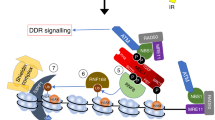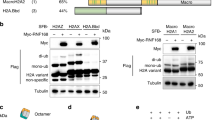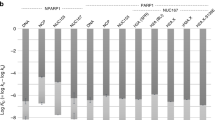Abstract
DNA double-strand break repair involves phosphorylation of histone variant H2AX ('γH2AX'), which accumulates in foci at sites of DNA damage. In current models, the recruitment of multiple DNA repair proteins to γH2AX foci depends mainly on recognition of this 'mark' by a single protein, MDC1. However, DNA repair proteins accumulate at γH2AX sites without MDC1, suggesting that other 'readers' of this mark exist. Here, we use a quantitative chemical proteomics approach to profile direct, phospho-selective γH2AX binders in native proteomes. We identify γH2AX binders, including the DNA repair mediator 53BP1, which we show recognizes γH2AX through its BRCT domains. Furthermore, we investigate the targeting of wild-type 53BP1, or a mutant form deficient in γH2AX binding, to chromosomal breaks resulting from endogenous and exogenous DNA damage. Our results show how direct recognition of γH2AX modulates protein localization at DNA damage sites, and suggest how specific chromatin mark–reader interactions contribute to essential mechanisms ensuring genome stability.
This is a preview of subscription content, access via your institution
Access options
Subscribe to this journal
Receive 12 print issues and online access
$259.00 per year
only $21.58 per issue
Buy this article
- Purchase on Springer Link
- Instant access to full article PDF
Prices may be subject to local taxes which are calculated during checkout






Similar content being viewed by others
References
Ciccia, A. & Elledge, S.J. The DNA damage response: making it safe to play with knives. Mol. Cell 40, 179–204 (2010).
Lord, C.J. & Ashworth, A. The DNA damage response and cancer therapy. Nature 481, 287–294 (2012).
Jenuwein, T. & Allis, C.D. Translating the histone code. Science 293, 1074–1080 (2001).
Rogakou, E.P., Pilch, D.R., Orr, A.H., Ivanova, V.S. & Bonner, W.M. DNA double-stranded breaks induce histone H2AX phosphorylation on serine 139. J. Biol. Chem. 273, 5858–5868 (1998).
Stucki, M. et al. MDC1 directly binds phosphorylated histone H2AX to regulate cellular responses to DNA double-strand breaks. Cell 123, 1213–1226 (2005).
Spycher, C. et al. Constitutive phosphorylation of MDC1 physically links the MRE11–RAD50–NBS1 complex to damaged chromatin. J. Cell Biol. 181, 227–240 (2008).
Jackson, S.P. & Durocher, D. Regulation of DNA damage responses by ubiquitin and SUMO. Mol. Cell 49, 795–807 (2013).
Pei, H. et al. MMSET regulates histone H4K20 methylation and 53BP1 accumulation at DNA damage sites. Nature 470, 124–128 (2011).
Lou, Z. et al. MDC1 maintains genomic stability by participating in the amplification of ATM-dependent DNA damage signals. Mol. Cell 21, 187–200 (2006).
Nakamura, A.J., Rao, V.A., Pommier, Y. & Bonner, W.M. The complexity of phosphorylated H2AX foci formation and DNA repair assembly at DNA double-strand breaks. Cell Cycle 9, 389–397 (2010).
Taverna, S.D., Li, H., Ruthenburg, A.J., Allis, C.D. & Patel, D.J. How chromatin-binding modules interpret histone modifications: lessons from professional pocket pickers. Nat. Struct. Mol. Biol. 14, 1025–1040 (2007).
Li, X. et al. Quantitative chemical proteomics approach to identify post-translational modification-mediated protein-protein interactions. J. Am. Chem. Soc. 134, 1982–1985 (2012).
Li, X. et al. Examining post-translational modification-mediated protein-protein interactions using a chemical proteomics approach. Protein Sci. 22, 287–295 (2013).
Campbell, S.J., Edwards, R.A. & Glover, J.N.M. Comparison of the structures and peptide binding specificities of the BRCT domains of MDC1 and BRCA1. Structure 18, 167–176 (2010).
Yang, Y.Y., Grammel, M., Raghavan, A.S., Charron, G. & Hang, H.C. Comparative analysis of cleavable azobenzene-based affinity tags for bioorthogonal chemical proteomics. Chem. Biol. 17, 1212–1222 (2010).
Orth, J.D., Loewer, A., Lahav, G. & Mitchison, T.J. Prolonged mitotic arrest triggers partial activation of apoptosis, resulting in DNA damage and p53 induction. Mol. Biol. Cell 23, 567–576 1 (2012).
DiTullio, R.A. Jr. et al. 53BP1 functions in an ATM-dependent checkpoint pathway that is constitutively activated in human cancer. Nat. Cell Biol. 4, 998–1002 (2002).
Fernandez-Capetillo, O. et al. DNA damage-induced G2-M checkpoint activation by histone H2AX and 53BP1. Nat. Cell Biol. 4, 993–997 (2002).
Schultz, L.B., Chehab, N.H., Malikzay, A. & Halazonetis, T.D. p53 binding protein 1 (53BP1) is an early participant in the cellular response to DNA double-strand breaks. J. Cell Biol. 151, 1381–1390 (2000).
Wang, B., Matsuoka, S., Carpenter, P.B. & Elledge, S.J. 53BP1, a mediator of the DNA damage checkpoint. Science 298, 1435–1438 (2002).
Wood, J.L., Singh, N., Mer, G. & Chen, J. MCPH1 functions in an H2AX-dependent but MDC1-independent pathway in response to DNA damage. J. Biol. Chem. 282, 35416–35423 (2007).
Dobbin, M.M. et al. SIRT1 collaborates with ATM and HDAC1 to maintain genomic stability in neurons. Nat. Neurosci. 16, 1008–1015 (2013).
Hu, B., Li, S., Zhang, X. & Zheng, X. HSCARG, a novel regulator of H2A ubiquitination by downregulating PRC1 ubiquitin E3 ligase activity, is essential for cell proliferation. Nucleic Acids Res. 42, 5582–5593 (2014).
Oberdoerffer, P. et al. SIRT1 redistribution on chromatin promotes genomic stability but alters gene expression during aging. Cell 135, 907–918 (2008).
Bunting, S.F. et al. 53BP1 inhibits homologous recombination in Brca1-deficient cells by blocking resection of DNA breaks. Cell 141, 243–254 (2010).
Dimitrova, N., Chen, Y.C., Spector, D.L. & de Lange, T. 53BP1 promotes non-homologous end joining of telomeres by increasing chromatin mobility. Nature 456, 524–528 (2008).
Zimmermann, M., Lottersberger, F., Buonomo, S.B., Sfeir, A. & de Lange, T. 53BP1 regulates DSB repair using Rif1 to control 5′ end resection. Science 339, 700–704 (2013).
Huyen, Y. et al. Methylated lysine 79 of histone H3 targets 53BP1 to DNA double-strand breaks. Nature 432, 406–411 (2004).
Botuyan, M.V. et al. Structural basis for the methylation state-specific recognition of histone H4–K20 by 53BP1 and Crb2 in DNA repair. Cell 127, 1361–1373 (2006).
Fradet-Turcotte, A. et al. 53BP1 is a reader of the DNA-damage-induced H2A Lys 15 ubiquitin mark. Nature 499, 50–54 (2013).
Manke, I.A., Lowery, D.M., Nguyen, A. & Yaffe, M.B. BRCT repeats as phosphopeptide-binding modules involved in protein targeting. Science 302, 636–639 (2003).
Yu, X., Chini, C.C., He, M., Mer, G. & Chen, J. The BRCT domain is a phospho-protein binding domain. Science 302, 639–642 (2003).
Ward, I.M., Minn, K., Jorda, K.G. & Chen, J. Accumulation of checkpoint protein 53BP1 at DNA breaks involves its binding to phosphorylated histone H2AX. J. Biol. Chem. 278, 19579–19582 (2003).
Joo, W.S. et al. Structure of the 53BP1 BRCT region bound to p53 and its comparison to the Brca1 BRCT structure. Genes Dev. 16, 583–593 (2002).
Clapperton, J.A. et al. Structure and mechanism of BRCA1 BRCT domain recognition of phosphorylated BACH1 with implications for cancer. Nat. Struct. Mol. Biol. 11, 512–518 (2004).
Huen, M.S. et al. RNF8 transduces the DNA-damage signal via histone ubiquitylation and checkpoint protein assembly. Cell 131, 901–914 (2007).
Kolas, N.K. et al. Orchestration of the DNA-damage response by the RNF8 ubiquitin ligase. Science 318, 1637–1640 (2007).
Rogakou, E.P., Boon, C., Redon, C. & Bonner, W.M. Megabase chromatin domains involved in DNA double-strand breaks in vivo. J. Cell Biol. 146, 905–916 (1999).
Cotsiki, M. et al. Simian virus 40 large T antigen targets the spindle assembly checkpoint protein Bub1. Proc. Natl. Acad. Sci. USA 101, 947–952 (2004).
Murray, J.M., Stiff, T. & Jeggo, P.A. DNA double-strand break repair within heterochromatic regions. Biochem. Soc. Trans. 40, 173–178 (2012).
Hammet, A., Magill, C., Heierhorst, J. & Jackson, S.P. Rad9 BRCT domain interaction with phosphorylated H2AX regulates the G1 checkpoint in budding yeast. EMBO Rep. 8, 851–857 (2007).
Nakamura, T.M., Du, L.L., Redon, C. & Russell, P. Histone H2A phosphorylation controls Crb2 recruitment at DNA breaks, maintains checkpoint arrest, and influences DNA repair in fission yeast. Mol. Cell. Biol. 24, 6215–6230 (2004).
Sanders, S.L., Arida, A.R. & Phan, F.P. Requirement for the phospho-H2AX binding module of Crb2 in double-strand break targeting and checkpoint activation. Mol. Cell. Biol. 30, 4722–4731 (2010).
Bothmer, A. et al. Regulation of DNA end joining, resection, and immunoglobulin class switch recombination by 53BP1. Mol. Cell 42, 319–329 (2011).
Callen, E. et al. 53BP1 mediates productive and mutagenic DNA repair through distinct phosphoprotein interactions. Cell 153, 1266–1280 (2013).
Ward, I. et al. The tandem BRCT domain of 53BP1 is not required for its repair function. J. Biol. Chem. 281, 38472–38477 (2006).
Cann, K.L. & Dellaire, G. Heterochromatin and the DNA damage response: the need to relax. Biochem. Cell Biol. 89, 45–60 (2011).
Noon, A.T. et al. 53BP1-dependent robust localized KAP-1 phosphorylation is essential for heterochromatic DNA double-strand break repair. Nat. Cell Biol. 12, 177–184 (2010).
Schoeftner, S. & Blasco, M.A.A. 'Higher order' of telomere regulation: telomere heterochromatin and telomeric RNAs. EMBO J. 28, 2323–2336 (2009).
Ruthenburg, A.J., Li, H., Patel, D.J. & Allis, C.D. Multivalent engagement of chromatin modifications by linked binding modules. Nat. Rev. Mol. Cell Biol. 8, 983–994 (2007).
Cox, J. & Mann, M. MaxQuant enables high peptide identification rates, individualized p.p.b.-range mass accuracies and proteome-wide protein quantification. Nat. Biotechnol. 26, 1367–1372 (2008).
Acknowledgements
We are grateful to T. de Lange for the generous gift of 53BP1- and MDC1-deficient MEFs and for helpful discussions. We thank F. Lottersberger for advice and assistance with DNA damage assays. We thank S. Jackson for graciously providing a plasmid encoding MDC1-BRCT cDNA. Live-cell imaging was performed at the Rockefeller University Bio-Imaging Resource Center. We thank P. Ariel for technical assistance with laser scissors. Peptide synthesis was performed by the Rockefeller University Proteomics Resource Center. We thank R. Pisa for assistance with peptide probe synthesis and E. Foley for assistance with pilot experiments. R.E.K. is the Miles S. Nadal Fellow of the Damon Runyon Cancer Research Foundation (DRG-2118-12). The authors acknowledge support from the US National Institutes of Health (GM98579 to T.M.K. and P41 GM103314 and GM109824 to B.T.C.).
Author information
Authors and Affiliations
Contributions
R.E.K. and T.M.K. conceived the project, designed experiments and wrote the paper. R.E.K. designed probes, performed mass spectrometry data collection and analysis, performed biochemical characterization and carried out cellular studies. P.V. validated probes and performed photo-crosslinking experiments. K.R.M. guided mass spectrometry data collection and analysis. B.T.C. directed K.R.M.
Corresponding author
Ethics declarations
Competing interests
The authors declare no competing financial interests.
Supplementary information
Supplementary Text and Figures
Supplementary Results, Supplementary Figures 1–10 and Supplementary Table 1. (PDF 5165 kb)
Supplementary Dataset 1
Mass spectrometry dataset containing SILAC ratios and protein identifiers from 'affinity filter' experiment. Separate file is attached with the article. (XLSX 158 kb)
Supplementary Dataset 2
Mass spectrometry dataset containing SILAC ratios and protein identifiers from 'selectivity filter' experiment. Separate file is attached with the article. (XLSX 221 kb)
Rights and permissions
About this article
Cite this article
Kleiner, R., Verma, P., Molloy, K. et al. Chemical proteomics reveals a γH2AX-53BP1 interaction in the DNA damage response. Nat Chem Biol 11, 807–814 (2015). https://doi.org/10.1038/nchembio.1908
Received:
Accepted:
Published:
Issue Date:
DOI: https://doi.org/10.1038/nchembio.1908
This article is cited by
-
Trypanosoma cruzi infection induces DNA double-strand breaks and activates DNA damage response pathway in host epithelial cells
Scientific Reports (2024)
-
PKMYT1: A Potential Target for CCNE1 Amplificated Colorectal Tumors
Cell Biochemistry and Biophysics (2023)
-
Tools used to assay genomic instability in cancers and cancer meiomitosis
Journal of Cell Communication and Signaling (2022)
-
Spatiotemporal dynamics of 53BP1 dimer recruitment to a DNA double strand break
Nature Communications (2020)
-
MDC1 PST-repeat region promotes histone H2AX-independent chromatin association and DNA damage tolerance
Nature Communications (2019)



